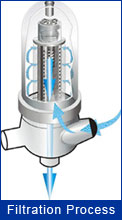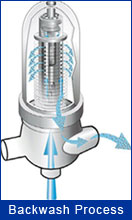SpinKlin Disc Filtration Technology
At the heart of our disc filter are color coded polypropylene or nylon discs. These discs are grooved on both sides for a specific micron rating, then stacked and compressed on a specifically designed spine. The groove on top runs opposite the groove below creating a series of intersecting grooves that trap solids.This automated disc filtration system is specifically targeted to pre-filtration of MF and UF membranes and water purification technologies. Precise filtration from 400 down to 20 microns is available. Filtration is effective for treatment of surface water, seawater and wastewater streams containing high amounts of suspended solids including algae.
Filtration Process DescriptionFilter discs are stacked on a spine assembly that is specially designed to compress the filter element. Inside the spine a spring and the pressure differential compress the discs tightly during the filtration process. This forces the water to flow between the grooves in the discs with the solids being trapped between.Backwash Process DescriptionActivated by defined commands (time and pressure differential) alternate units of the disc system go into backwash.The inlet valve shuts as the drain opens. The compression spring is released. The spine piston rises up, releasing the pressure on the discs. Tangential jets of water pass through the nozzles at the center of the spine in the opposite direction of filtration flow. The discs spin freely, quickly and efficiently, flushing out the solids. |
  |
Features & Benefits |
|
|
 |
Industry Applications
The unique and innovative technology present in the SpinKlin line of disc filters is integral in providing a much improved system for industrial water quality needs. Performance is achieved at a very high level without encountering drawbacks common in competing technologies with a backwash mechanism surpasses that of the finest screen filter. Several common industry applications where the SpinKlin disc filter system will produce outstanding results are outlined below.General Water Inlets
Food and Beverage, Textile, Chemicals, Mining, Electronics and Plastics
- Flow Rates 66 - 22,000 GPM, Particle Filtration 55-130 microns
Water ConcernsSuspended solids in inlet water requires removal per plant engineer or local authority's specification.
Solution
Installation of a modular automatic filtration system that will reject the specified suspended material size with minimum backwash volume, allowing for dramatic cost improvements as well as performance improvements. Up to 95% retention of specified particle size can be achieved. Backwash volume is kept in the range of 0.5% - 1% of product flow. Fully automatic, low maintenance while substantially reducing clogging related issues, recirculation increase and decrease of effluent discharge volume.
Fine Water Ducts and Nozzle Protection
Food and Beverage, Pulp & Paper, Steel Plastics, Machinery, Plastics
- Flow Rates 30 - 1,000 GPM, Particle Filtration 55-200 microns
Water ConcernsSuspended solids sediment and clog, acting as a nucleus for dissolved carbonates precipitation, significantly increasing maintenance costs and down time expenses. All fine nozzles and ducts are susceptible to this type of clogging leading to reduced water abstraction.
Solution using Disc Filtration
Filtering at a clogging free grade calculated according to nozzle orifice. Compact system design enables placement in an optimal location. Nozzle clogging is reduced 98% even under periods of high solids load. If unexpected high solid loads are experienced the system will simply react by increasing backwash frequency and not allowing any solids breakthrough. The laborious task of cleaning nozzles will been minimized or in many cases eliminated effectively avoiding downtime.
Ion Exchange / Boiler Feed Systems (Upstream Filtration / Post Protection for Resin Traps)
Textile, Power Generation, Chemical, Petrochemical & Refineries, Pulp & Paper Steel, Machinery, Mining, Food & Beverage
- Flow Rates 1,000 GPM, Particle Filtration 55-100 microns (Upstream Filtration)
- Flow Rates 6,600 GPM, Particle Filtration130 microns (Post Protection for Resin Traps)
Water ConcernsDepending on the water source, resin beds may be currently used as filters. This is not an intended or optimal use and such a system will suffer clogs or increased regeneration frequency as well as brine discharge and salt consumption. Suspended materials accumulate on the exchange resin which decreases its capacity and exchange rate. If regeneration is not performed, according to preselected operation conditions, a certain volume of resin may escape during or immediately after regeneration.
Solution using Disc Filtration
Upstream filtration - An automatic filtration system will reduce the incoming suspended matter allowing the ion exchange bed to perform is intended task. Unparalleled protection in plants where all incoming water is ionized as well as in boiler feed preparation streams.


